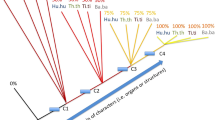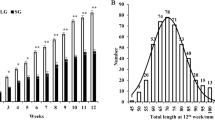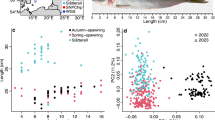Abstract
The hypothesis that enzyme heterozygosity is positively related to phenotypic characteristics in fish was tested using five polymorphic enzyme loci and seven anatomical characteristics in samples of North Irish Sea herring, Clupea harengus. Though not unambiguous the results indicated that heterozygosity was associated with increased developmental stability. Also, multiple homozygosity was negatively correlated with growth parameter estimates. Though no single locus correlates were evident, the level of multiple heterozygosity of an individual appeared to be positively related to body length.
Similar content being viewed by others
Article PDF
References
Barlow, G W. 1961. Causes and significance of morphological variation in fishes. Syst Zool, 10, 105–117.
Beardmore, J A, and Shami, S A. 1979. Heterozygosity and the optimum phenotype under stabilising selection. Aquilo Ser Zool, 20, 100–110.
Eanes, W F. 1978. Morphological variance and enzyme heterozygosity in the monarch butterfly. Nature, 276, 263–264.
Ferguson, A. 1980. Biochemical Systematics and Evolution. Blackie, Glasgow.
Fleischer, R C, Johnston, R J, and Klitz, W J. 1983. Alozymic heterozygosity and morphological variation in house sparrows. Nature. 304, 628–629.
Harris, H, and Hopkinson, D A. 1976. Handbook of Enzyme Electrophoresis in Human Genetics. North-Holland, Amsterdam.
King, D P F. 1983. Genetic and Morphometric Analyses of Atlantic Herring (Clupea harengus L) Stocks of the West of the British Isles with Particular Reference to the North Irish Sea. Ph.D. Thesis, Queen's University, Belfast.
Koehn, R K, and Shumway, S E. 1982. A Genetic/Physiological explanation for differential growth rate among individuals of the American oyster, Crassostrea virginica (Gmelin). Marine Biology Letters, 3, 35–42.
Leary, R F, Allendorf, F W, and Knudsen, K L. 1983. Developmental stability and enzyme heterozygosity in rainbow trout. Nature, 301, 71–72.
Lerner, I M. 1954. Genetic Homeostasis. Oliver & Boyd, Edinburgh.
Marriott, F H C. 1974. The Interpretation of Multiple Observations. Academic Press.
Mitton, J B. 1978. Relationship between heterozygosity for enzyme loci and variation of morphological characters in natural populations. Nature, 73, 661–662.
McAndrew, B J, Ward, R D, and Beardmore, J A. 1982. Lack of relationship between morphological variance and enzyme heterozygosity in the plaice, (Pleuronectes platessa). Heredity, 48, 117–125.
Singh, S M, and Zouros, E. 1978. Genetic variation associated with growth rate in the American oyster (Crassostrea virginica). Evolution, 32, 34–353.
Smith, M H, and Chesser, R K. 1981. Rationale for conserving genetic variation of fish gene pools. Ecol Bull, 34, 13–20.
Sved, J A, Reed, T E, and Bodmer, W F. 1967. The number of balanced polymorphisms that can be maintained in a natural population. Genetics, 55, 469–481.
Taggart, J B. 1981. An Electrophoretic Study of Genetic Variation in Irish Brown Trout (Salmo Trutta L.). Ph.D. Thesis, Queen's University, Belfast.
Wheat, T E, Childers, W F, and Whitt, G S. 1974. Biochemical genetics of hybrid sunfish: Differential survival of heterozygotes. Biochem Genet, 11, 205–219.
Winberg, G G. 1956. Rate of metabolism and food requirements of fishes. Fish Res Board Can, 194, 1–253.
Zouros, E. 1976. Hybrid molecules and the superiority of the heterozygote. Nature, 262, 227–229.
Zouros, E, Singh, S M, and Miles, H E. 1980. Growth rate in oysters: an overdominant phenotype and its possible explanations. Evolution, 34, 856–867.
Author information
Authors and Affiliations
Rights and permissions
About this article
Cite this article
King, D. Enzyme heterozygosity associated with anatomical character variance and growth in the herring (Clupea harengus L.). Heredity 54, 289–296 (1985). https://doi.org/10.1038/hdy.1985.39
Received:
Issue date:
DOI: https://doi.org/10.1038/hdy.1985.39
This article is cited by
-
Evolution of Adaptation and Mate Choice: Parental Relatedness Affects Expression of Phenotypic Variance in a Natural Population
Evolutionary Biology (2008)
-
Inheritance of Behavioral and Neuroanatomical Phenotypical Variance: Hybrid Mice Are Not Always More Stable Than Inbreds
Behavior Genetics (2006)
-
Increase in developmental instability upon inbreeding in Daphnia
Heredity (1997)
-
Heterozygosity at the malate dehydrogenase locus and developmental homeostasis in Apis mellifera
Heredity (1996)
-
Geographical variation in shell morphology and isoenzymes of Helix aspersa Müller, 1774 (Gastropoda, Pulmonata), the edible land snail, from Greece and Cyprus
Heredity (1994)



